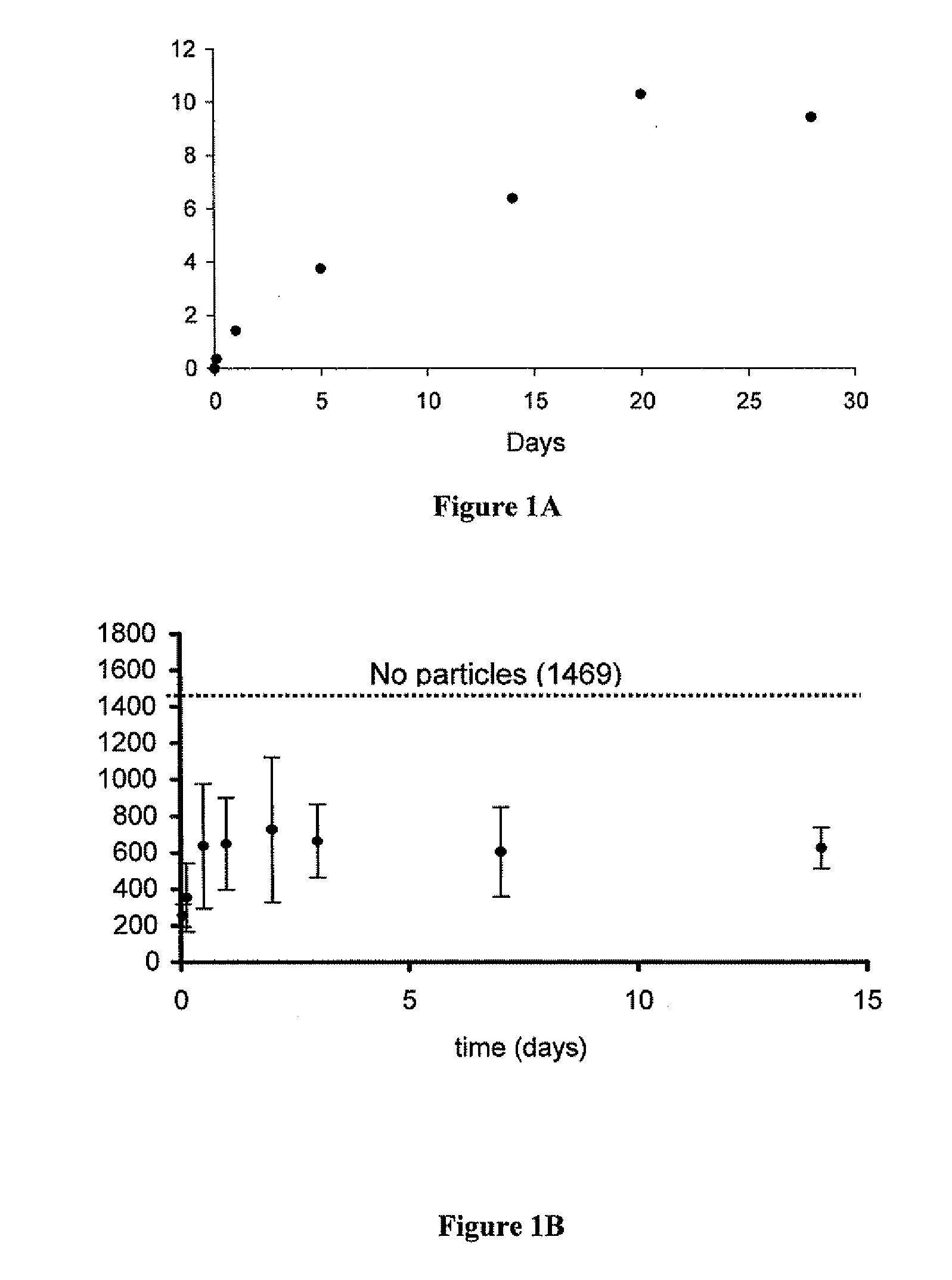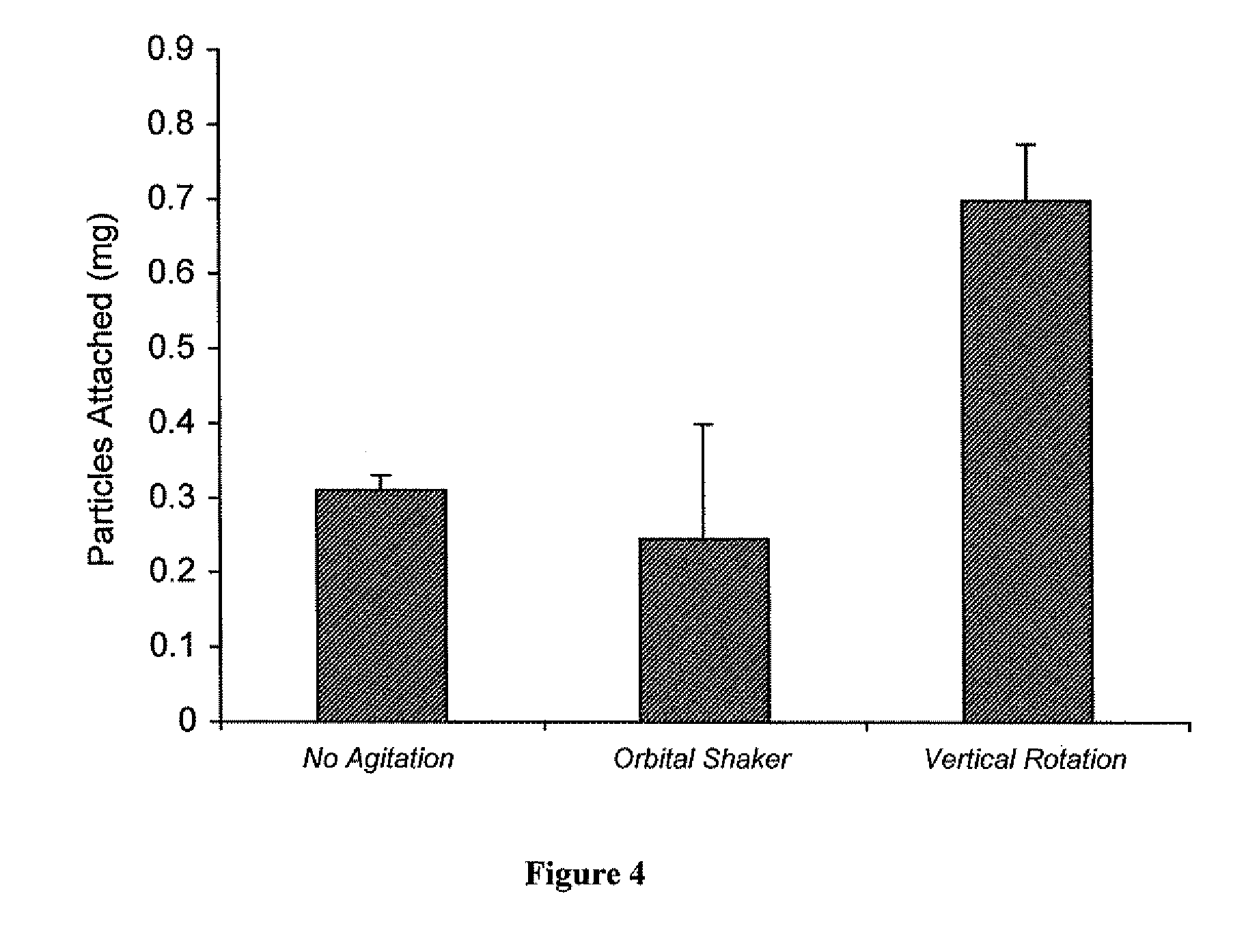Methods for Ex Vivo Administration of Drugs to Grafts Using Polymeric Nanoparticles
a technology of polymer nanoparticles and nanoparticles, which is applied in the direction of prosthesis, surgery, catheters, etc., can solve the problems of autograft rejection, many patients experience life-threatening side effects, and autografts do not always adapt to life-threatening side effects, so as to facilitate the attachment of nanoparticles, inhibit hyperplasia, and prevent the rejection of grafts
- Summary
- Abstract
- Description
- Claims
- Application Information
AI Technical Summary
Benefits of technology
Problems solved by technology
Method used
Image
Examples
example 1
Controlled Release of Drugs from Nanoparticles
[0096]Materials and Methods:
[0097]Five milligrams of rapamycin-loaded nanospheres were placed in 18 different tubes and suspended in 0.5 mls of phosphate buffered saline. The tubes were then incubated at 37° C. on a rotary shaker. At various time points, three of the tubes were removed and centrifuged to pellet the nanospheres. The supernatant was discarded and the nanospheres dissolved in NaOH to release all of the encapsulated rapamycin. The amount of released rapamycin was measured by absorption at 290 nm and converted to micrograms from a standard curve. This value, rapamycin remaining in the particles after PBS incubation, was then subtracted from the total amount of rapamycin encapsulated to yield the total amount released at that time point.
[0098]The bioactivity of the released rapamycin was then determined by PBMC assay. Briefly, PBMC cells were stimulated with IL-12 and IL-18. The levels of interferon released from PBMC cells we...
example 2
Localized Coating of Vascular Grafts with Nanoparticles
[0101]Materials and Methods:
[0102]Rhodamine-loaded nanoparticles were used to demonstrate attachment (and impregnation) of nanoparticles to vascular wall of a human saphenous vein. Vascular grafts were either not coated, lumen- or intima-coated, adventia-coated, or both intima- and adventia-coated. To coat the vascular grafts 5 mgs of avidin-coated rhodamine nanoparticles were placed in a 5 ml scinillation vial and then suspended in a solution of Pluronic F-127 (300 μl of 10% Pluronic in DMSO and 2700 μl of PBS). The glass vial was then fixed to a vertical carousel of a hybridization oven and mixed for 20 minutes (maximal RPM, 25° C.). Parafilm was used to cover the portion of the vessel not to be coated.
[0103]Results:
[0104]Rhodamine nanoparticles were clearly visible in the intima of the graft which was intima-coated and likewise in the adventia of the graft which was adventia-coated. A greater degree of attached rhodamine nano...
example 3
Amount of Coating of Vascular Grafts with Nanoparticles
[0105]Materials and Methods:
[0106]Two different sizes of ovine vascular tissue, 30 mm2 (n=3) and 10 mm2 (n=3), were coated with rhodamine nanoparticles and evaluated for amount of bound nanoparticles. The tissues were either coated with avidin rhodamine nanospheres or blank rhodamine nanospheres. After coating, the pieces of tissue were rinsed in distilled water three times, frozen and lyophilized. After two days the tissue was removed from the lyophilizer and suspended in 0.5 ml of DMSO for 4 hours to dissolve the nanospheres, thereby releasing the encapsulated rhodamine. The 0.5 ml of DMSO was then removed from the tissue and mixed with 0.5 ml of distilled water. This mixture was allowed to set for 30 minutes and then centrifuged to remove any precipitated polymer or loose tissue, and then scanned for fluorescence (ex. 550, em. 580). The resultant value was used to calculate the amount of particles attached.
[0107]Results:
[0108...
PUM
| Property | Measurement | Unit |
|---|---|---|
| Diameter | aaaaa | aaaaa |
| Diameter | aaaaa | aaaaa |
| Diameter | aaaaa | aaaaa |
Abstract
Description
Claims
Application Information
 Login to View More
Login to View More - R&D
- Intellectual Property
- Life Sciences
- Materials
- Tech Scout
- Unparalleled Data Quality
- Higher Quality Content
- 60% Fewer Hallucinations
Browse by: Latest US Patents, China's latest patents, Technical Efficacy Thesaurus, Application Domain, Technology Topic, Popular Technical Reports.
© 2025 PatSnap. All rights reserved.Legal|Privacy policy|Modern Slavery Act Transparency Statement|Sitemap|About US| Contact US: help@patsnap.com



